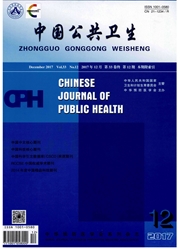

 中文摘要:
中文摘要:
目的 了解黑龙江省大学生参与应急志愿服务的意愿,并分析其影响因素,为制定相应的干预策略提供依据。方法 采用多阶段分层整群抽样方法,于2014年3—5月抽取黑龙江省7所高校的1 806名在校大学生进行问卷调查,运用一般描述性分析、χ2检验与多因素logistic回归分析大学生参与应急志愿服务的意愿。结果有71.1%的大学生愿意参加应急志愿服务,33.5%的大学生参加过应急志愿服务;大学生愿意提供的应急志愿服务类型占前3位的分别是服务(老、少、病、伤)(69.8%)、慰问探访(62.6%)、物资搬运(48.7%);女性、健康状况良好、居住地类型为城镇/农村、应急准备状态(风险意识、应急态度、应急心理、应急准备行为倾向)良好、掌握应急知识与技能、过去1年接受过应急宣传培训演练的大学生的报告率较高(P〈0.05);多因素logistic回归分析结果显示,大学生参与应急志愿服务意愿的促进因素为女性(OR=2.067)、居住地类型为城镇/农村(OR=1.410)、健康状况良好(OR=1.540)、应急态度良好(OR=1.817)、应急心理良好(OR=1.391)、具备应急准备行为倾向(OR=1.457)、掌握应急知识与技能(OR=1.301)、在过去1年里接受过应急宣传培训演练(OR=1.439)。结论应急志愿服务已被多数大学生认同和接受,但其参与意愿仍有待提高,高校应从应急教育入手,通过提高大学生的应急能力,改善大学生的应急准备状态,进而提高大学生参与应急志愿服务的积极性。
 英文摘要:
英文摘要:
Objective To examine the college students' willingness to participate in volunteer emergency service and its influencing factors and to provide evidences for developing effective strategies and intervention measures. Meth- ods A questionnaire survey was conducted among 1 806 students selected with multi-stage random cluster sampling method from 7 universities in Heilongjiang province. General descriptive analysis, X2 test, and multivariate logistic regres- sion were adopted in data analyses. Results Of the college students surveyed,71.1% were willing to provide volunteer emergency service and 33.5% had the experience of participating in volunteer emergency service. The first three volun- teer emergency services the students intending to provide were support services to the elderly, the young, the sick, and the injured (69. 8% ) ,consolatory visit to victims (62. 6% ) ,and material handlings (48. 7% ). Higher willingness was re- ported by female students and the students with good health, living in towns or rural areas, with good preparedness for possible emergency ( risk awareness and emergency-related attitude, mental status, and behavioral manner), having good knowledge about emergency response, having received emergency training in the previous one year ( P 〈 0. 05 for all). The results of logistic regression analysis showed that the promoting factors for the willingness to provide volunteer emergency service were female ( odds ratio E OR] = 2. 067 ) ,living in towns or rural areas ( OR = 1. 410), good health condition ( OR = 1. 540) ,appropriate emergency attitude ( OR = 1. 817 ), good mental status ( OR = 1. 391 ), good emergency related behavioral manner ( OR = 1. 457), having emergency management-related knowledge and skills ( OR = 1. 301 ), and attending emergency management-related training in the previous one year ( OR = 1. 439). Conclusion Volunteer emergency service has been approved and accepted by the most of college students, but the willingne
 同期刊论文项目
同期刊论文项目
 同项目期刊论文
同项目期刊论文
 期刊信息
期刊信息
